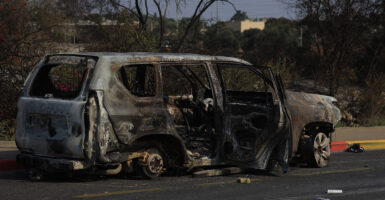WARNING: Some of the descriptions and images below are graphic and disturbing.
How quickly can I get to the bathroom if I need to throw up? I was shoulder to shoulder with men and women in suits, faith leaders who had come to the Embassy of Israel in Washington, D.C., for a screening of a film containing raw footage of Hamas’ attack on Israel on Oct. 7.
On the screen in front of me played body camera footage from Hamas terrorists, as well as surveillance footage, and videos taken by Israeli citizens and Israel Defense Force soldiers. For 45 minutes, the 75 or so people in the room and I sat in silence, trying to absorb what we were watching.
A home surveillance camera showed a father hurrying his two boys out of their home and into a structure in the backyard. Moments later, a Hamas terrorist can be seen throwing a form of grenade into the structure. The father’s body falls back into frame. He’s dead. The two boys are bloodied with shrapnel in their bodies. The kids reenter their home as a terrorist rummages through their refrigerator for a drink.
The brother that appears to be the older child asked his brother if he can see out of his right eye.
“No,” the boy responds.
“You’re not joking?” the other brother questions him.
“No,” he says.
The Embassy of Israel did confirm that the two brothers were rescued and are safe, though the one brother is blind in one of his eyes.
In another clip, a small group of terrorists approach a home, and a dog walks in front of them. Pop, pop, pop. The dog falls dead. The Hamas terrorists move to a home and begin lighting objects on the porch on fire.
On the streets, Hamas opens fire on any vehicle they see. Sometimes they drag the dead bodies out of the car and take the vehicle for themselves.
An IDF soldier approaches the scene of the music festival that took place close to Gaza in Israel on the morning of Oct. 7. He draws near the first few bodies he sees on the ground following the attack that took place earlier that day. They are dead. He looks behind the bar area and bodies lay everywhere. He begins to shout, asking for anyone who is alive to make some sound of life. Silence.
Video and photos from IDF soldiers show two skeleton bodies burned to a state of being unrecognizable in the backseat of a car. Photos of open body bags display bloodied and bruised bodies of men, women, children, and babies.
I tried not to look away as the footage played, but I had to close my eyes when a Hamas terrorist began attempting to decapitate a man with what looked to be a gardening tool.
History is filled with atrocities that we learn about in school, and when we do, there is an implication that we, as a civilization, have largely risen above such horrific actions. But in the hours after watching the film of the Hamas attack, I struggled to know how to process what I had witnessed. This was not decades-old historical footage. I remember very clearly what I was doing five weeks ago on Oct. 7. The dead bodies on the screen were not soldiers—many of them were young women my age. Modern “civilized society” has not destroyed horror.
What I witnessed can only be described as evil. I struggle to know how to conclude because there is no happy ending in the immediate future. About 1,400 Israelis were slaughtered on Oct. 7. Still, an estimated 240 hostages remain captive to Hamas in Gaza. A war is raging that has left thousands of Palestinians dead as Hamas uses civilians as human shields with operations located below hospitals and under densely populated communities.
The only response I can offer in the face of such evil is one of prayer for the power of Christ to move, to set the captives free, to heal broken hearts and bodies, and to bring peace.
The 45-minute film has not been released to the public because, as embassy officials explained, some family members of those murdered have not yet seen the footage and out of respect for them, the film will not be released broadly at this time.
Some of the video clips included in the film have been shared on social media and can be viewed below. Please be mindful that the footage is graphic.
On this week’s edition of the “Problematic Women” podcast, we discuss the atrocities of Oct. 7 and why a cease-fire is not an option for Israel.
Listen to the podcast below:

























